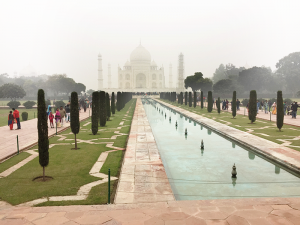My Impressions of India
My visit to this complex, fascinating country
Second in a three-part series
By Marilyn L. Pinsky

In the recent movie “Lion,” a true story that takes place in India, there is a scene at a train station where a frantic young boy is trying to tell people he is lost and needs to find his family. But no one can understand him because he fell asleep on a train and woke up in another state hours from his home they speak a different language.
It would be as if you left Oswego and got off the train in Albany and the people didn’t speak English and you had no way of asking directions.
That is one of the complexities of India — there are 29 states and seven union territories and 23 recognized official languages. (Though for people who want to get ahead, English is their first or second language.)
I feel like it is important to mention the caste system as it always comes up in conversation when talking about India and the people in our group had many questions about it.
I can only give a superficial impression and I don’t think it’s fair to do that, so I will just say that it influences every segment of life in India, from jobs to social mobility.
The government is trying to change that with incentives for education for people in lower castes and, indeed, there are people who are “untouchables” — also known as Dalits — who have become doctors and legislators, but the numbers are still very small.
Like many countries, politics and religion are intermingled.
People in certain castes often vote as a bloc and political corruption is a fact of life. Communism is just another political party in India and a town we were in had that year elected a Communist political slate. Cuban dictator Fidel Castro had recently died and it was a bit incongruous to see posters of him hanging in a small Indian village square honoring his memory.
How can you write about India and not mention the Taj Mahal? It is truly beautiful. I had not known it had been built as a Muslim shrine and that at one point the British tried to sell it. Luckily we were there for a day and a half as the first day the smog was so bad that you couldn’t stand back and get a sense of its full beauty.
As you drive through the countryside, you see women in colorful saris working in the fields. After a while you get used to the bus stopping for cows, elephants, monkeys and, in some towns, donkeys that are in the road.
We had a seven-hour trip which was slowed down not just by the animals, but by the fog or smoke that hangs over much of the country, both big cities and rural areas.
You can see it, smell it and taste it in your mouth. Again, anyone in the US who chafes at our environmental laws, need only spend a day in India to see what it is like to live in a country without such restrictions.
As you pass through one rural village after another you only see men outside, rarely a woman and then never alone.
In the villages women stay home or work in the fields. You get used to the continual horn tooting and the roads are as filled with people in the dark as they are in the day.
I promise I will only write one more article on India, but the country made such an impression on me, that I can’t stop thinking about it.

